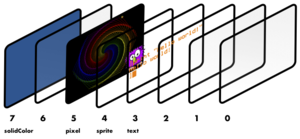Difference between revisions of "Display"
(Created page with "In Mini Micro, <c>Display</c> is the base class for all the display types, and the class of any display that is off (mode 0). In addition, <c>display</c> (all lowercase)...") |
|||
| Line 2: | Line 2: | ||
= Architecture of the display system = | = Architecture of the display system = | ||
| + | |||
| + | [[File:DisplayLayout.png|frameless|right]] | ||
Mini Micro supports eight simultaneous displays, numbered from 0 (frontmost) to 7 (in the back). Each display may be either off, or one of five more specific display types (solid color, text, pixels, tiles, or sprites). Any transparent or translucent areas of one display reveal the displays behind it. Behind all the display layers is solid black. | Mini Micro supports eight simultaneous displays, numbered from 0 (frontmost) to 7 (in the back). Each display may be either off, or one of five more specific display types (solid color, text, pixels, tiles, or sprites). Any transparent or translucent areas of one display reveal the displays behind it. Behind all the display layers is solid black. | ||
Revision as of 04:02, 26 March 2020
In Mini Micro, Display is the base class for all the display types, and the class of any display that is off (mode 0). In addition, display (all lowercase) is a function that returns one of the eight displays in Mini Micro's display system.
Contents
Architecture of the display system
Mini Micro supports eight simultaneous displays, numbered from 0 (frontmost) to 7 (in the back). Each display may be either off, or one of five more specific display types (solid color, text, pixels, tiles, or sprites). Any transparent or translucent areas of one display reveal the displays behind it. Behind all the display layers is solid black.
Display class
| Property | Purpose |
|---|---|
| Display.mode | get or set the display mode |
Subclasses
display function
The global display function returns a reference to the current display for the given layer number (0-7). Note that the display object in each layer changes when the mode is changed, so you will need to get a fresh reference (using this function) after changing the mode.
Arguments
| Parameter Name | Type | Default Value | Meaning |
|---|---|---|---|
| n | number | 0 | display (layer) number to get |
Example
This example sets display layer 2 to pixel mode, clears it, and then draws a big translucent purple ellipse.
display(2).mode = displayMode.pixel
g = display(2)
g.clear
g.fillEllipse 0, 0, 960, 640, "#8800FF88"
See also: displayMode
